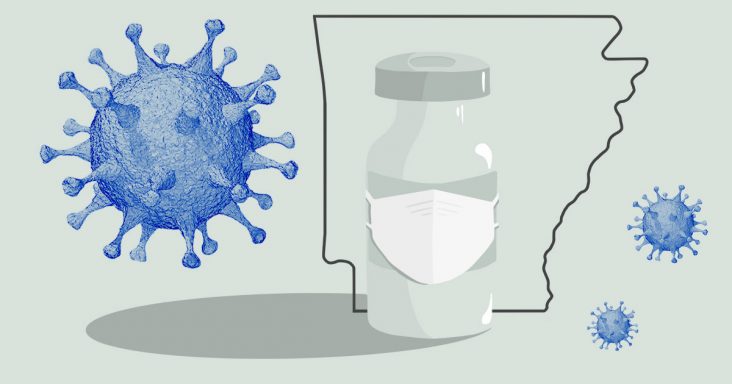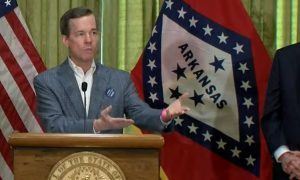Healthcare professionals see pandemic response as guide for inevitable future
by March 16, 2021 3:07 pm 679 views

Editor’s note: This is the third of four stories in a series about the first year of the COVID-19 pandemic in Arkansas. Link here for the first story, and link here for the second story.
A once-in-a-century pandemic has taught meaningful lessons to the state’s healthcare community, and likely prepared the industry for its next inevitable crisis and a transformation of epic scale.
With Arkansas passing the one-year mark last week of its first coronavirus case, healthcare leaders say there are a number of changes that will be permanent for their profession going forward.
“One of the first statements I made when the pandemic started was, ‘This hasn’t happened in 100 years. We’re going to make a lot of mistakes. We’re going to do some really good things. But for future generations, we’re going to be much better prepared as we go forward,’” said Eric Pianalto, president of Mercy Hospital Northwest Arkansas.
His region of the state bore the brunt of several waves of COVID-19. Pianalto sees one of the major issues to correct involving personal protective equipment (PPE), which was in short supply in the early months of the pandemic due to overseas suppliers. His counterpart in northeast Arkansas, St. Bernards CEO Chris Barber, expressed the same need for correction.
“It’d be nice to have some of these suppliers and PPE on so we’re sure we’re not dependent on foreign markets for a lot of those activities. I know hospitals really use a lot of just in time inventory. Folks are thinking a little differently about that now,” Barber said. “I think folks are seeing this as an opportunity to really kind of re-imagine the future and in anticipation of other events, but more importantly, what can we do differently in healthcare to be innovative, how can we engage the consumer differently?”
Barber, Pianalto and University of Arkansas for Medical Sciences Chancellor Dr. Cam Patterson, agreed that another takeaway from the 2020 pandemic is that we will experience another pandemic in the future – and it won’t take another 100 years. Patterson suggested the lessons learned over the past year will prove beneficial for the next crisis.
“There is a lot of our playbook that we have run over the past 365 days that we would run again,” he said. “If I think about what we would do differently, how we would prepare for the next time this comes up, we didn’t have the playbook on the shelves. We had to put together the plays as we went along, and I know that in preparation for the next pandemic that we have, and inevitably we will have one, that we will be better prepared.”
He knows fact-based messaging will be crucial for a future pandemic. A challenge he predicts for the next one is how to overcome the false narratives that became widespread due to lack of knowledge about the disease and the power of social media and messaging.
“We’ve all learned how powerful messaging education is, not only for the public but for the policymaking contingent. Getting facts out, making sure that people are getting correct information is so important. And we’ve seen the unfortunate power of misinformation over the course of the past year,” Patterson said.
Telemedicine is here to stay due to the pandemic. While hospitals and medical clinics have reduced operations temporarily, the embrace of telemedicine has been accelerated and will become much more normal in a post-pandemic world.

“I think people are going to look differently at how we engage the consumer in healthcare settings. That will change with our whole aspect of telemedicine and that was invaluable in the pandemic,” said Barber, who also foresees new reimbursement models for healthcare due to telemedicine. “I think you’ll see some different mindset of facility design and layout. Folks aren’t waiting in a waiting room now, and there will be reprogramming of existing space, both in clinics and hospitals. You’re seeing utilization patterns that are changing.”
WORKFORCE
With utilization shifting a new normal for hospital settings, the healthcare workforce is going to undergo massive transformation. There will be additional changes in workforce needs due other factors such as employee burnout, trauma and inspiration. All three healthcare leaders offered unique perspectives on how their personnel have managed the COVID-19 crisis and what’s in store for the future.
Patterson said the loss of life from frontline workers can’t be overlooked.
“First of all, take a minute and reflect on the fact that many healthcare workers died in the course of this pandemic through contact with patients that they were caring for,” he said. “There are simply some healthcare workers who are not around because of the work that they did and we need not forget that.”
“We’re going to have a lot of recovery to do for people who’ve been stressed out, who’ve been traumatized, who are having second thoughts about their careers. And whose family lives have been disrupted while they have been in hospital taking care of patients,” Patterson added.
Pianalto concurred and reminded people to consider that not only did healthcare workers confront the challenges of COVID-19 in their professional work, but they were dealing with it on a personal basis with their families too.
“They are resilient, but they’re tired. And they’re real people at the end of the day,” he said. “We sometimes forget that doctors, nurses, even our housekeepers, our entire workforce: They’re real people first. And they’re experiencing all of the things that we all experience at home from the pandemic, that were our frustrations at home, and that we couldn’t do the things that we would normally do. But then they come to work and there’s no relief at work either.”
The healthcare workers were dealing with difficult patient situations, too. At times, loved ones and family members weren’t allowed to enter hospitals or critical care units, and the doctors and nurses were left to hold the hands of the dying with no one else present. Witnessing higher rates of mortality can traumatize the bravest professionals.
“It has been a challenge on all of our healthcare workforce throughout the state, and many organizations have done a lot of things to create spaces for folks to decompress, talk about the issues that they were facing. We have various resources that have been available from the spiritual aspect, the emotional aspect, just to help walk folks through some of the traumatic experiences that individuals have lived through,” Barber said.
Barber and Pianalto are optimistic the pandemic will lead to a rebirth of interest in the medical professions. While some exited the field out of fear, especially older workers, many younger workers were inspired, they said.
“I tend to think because the public has been so supportive of the healthcare workforce, and done so much to celebrate the healthcare workforce, I tend to think it’ll make people run towards it, as opposed to run away from it,” Pianalto said.
“I do think you’ll see an uptick of folks applying to medical school, because individuals understand the purpose and the value at this point in time dealing with the pandemic. We’re hopeful that we’ll see that spark some interest in that if you want to do meaningful work in the lives of individuals and impact communities and states, this is a very rewarding process to be part of,” Barber said.
VACCINES
The power of the vaccines offers the most hope for a return to normalcy, according to all three healthcare executives. The speed at which modern science developed them and the promise of their efficacy is already making a difference. However, vaccine hesitancy is real and the goal of reaching herd immunity across America remains daunting.
“It is unlikely, even with mass vaccination, that COVID-19 completely goes away,” Patterson said. “First of all, we have a huge segment of our population that’s predisposed to vaccine denial. No vaccines are perfect, and we don’t know the durability of COVID-19 vaccination yet. Nobody’s been vaccinated long enough to really be able to allow us to understand that. Going forward, we will have to find out whether COVID-19 affects us on an annual basis, the way that other respiratory infections like influenza or the cold do.”
He said it will be years before we begin to fully understand the aftereffects of the disease on humans. Organ damage, recurrence of symptoms, and shorter lifespans are all possibilities, but until rigorous testing can be studied, those long-term medical problems won’t be known.
“We will need to learn more about COVID-19, see what that situation is. This doesn’t go away in the healthcare space and it creates new challenges and opportunities for us to manage this, but from a public health perspective and also from a clinical care perspective,” Patterson said.
But the hope of the vaccines is real for those who administer them and receive them. Pianalto said the hesitancy he’s seeing is more indicative of a “wait-and-see attitude” not a “no vaccine” mentality.
“There’s always going to be people who are resistant to taking any type of vaccine. There’s going to be an element of the population that won’t. But what I hear more from those that haven’t taken the vaccine that were eligible for it is, ‘I’d just like to wait and see how people do.’ And I’m seeing a lot of momentum now from storytelling of those that have gotten the vaccine,” he said.
He predicts that the supply of vaccines is about to far exceed demand with the ramp-up of production among manufacturers. Pianalto believes this will lead to more mass clinics in the coming weeks. Barber said the vaccines are “transforming” for many.
“It is transforming lives when you have individuals that have been holed up in their house, not able to see their loved ones or their family members. When they get that shot, that is an emotional experience, not only for the recipient, but also that caregiver that has provided that hope and that new future for someone as they move forward,” he said.
